by Mark Tancig | May 4, 2018
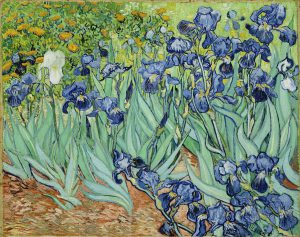
Irises by Vincent Van Gogh, 1889.
Have you noticed all of the blooming irises? Their striking shapes and colors grab my attention each time. Irises are named for the Greek word for rainbow and are often called flags. Irises, both true Iris and those with iris in the common name, are not only easy on the eyes, but also easy to grow in the Florida garden. North Florida gardeners have many varieties of iris to choose from, including those that prefer wet sites, drought-tolerant species, intricate hybrids, and native species.
All irises are in the plant family Iridaceae and have six flower petals; a lower set, called the sepals, or falls, and an upper set, known as standards, that are often upright. The base of the sepals, known as the signal, can have a variety of colors and patterns. Irises are clump forming plants with long, strap-shaped leaves. They need occasional dividing and propagate easy by rhizomes. Few pests bother them.
Here are a few common iris plants that grow well in our area.
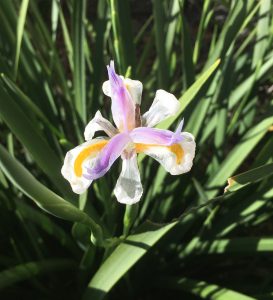
African Iris blooming on January 2nd, 2018 in the Leon County Extension Office Demonstration Garden. Credit: Mark Tancig, UF/IFAS Extension Leon County.
African Iris (Dietes vegeta)
This non-native plant is not actually a true Iris but is a tough and versatile plant. Its sepals are bright white with a yellow signal. The standards are purple. This plant can be grown in full sun or part shade, from standing water to droughty conditions. It works nicely as a border or foundation planting. Flowers only last a few days but are produced throughout the year. We had one blooming in our Demonstration Garden through a cold snap this past January. Cold weather can cause leaves to turn brown or gray, requiring some maintenance to improve appearance.
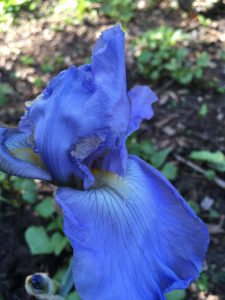
Bearded Iris. Credit: Mark Tancig, UF/IFAS Extension Leon County.
Bearded Iris (Iris x germanica)
A non-native, true Iris, bearded irises are the fancy hybrids that can come in many different colors. The “bearded” refers to the many hairs along the signal. Bearded irises prefer sunny locations and bloom in spring.
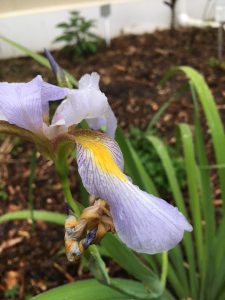
Iris versicolor. Credit: Mark Tancig, UF/IFAS Extension Leon County.
Blue Flag Iris (Iris versicolor and Iris virginica)
Two species of Iris go by the same common name, blue flag iris. These two are often misidentified in the nursery trade as well. Both have purple flowers that bloom in the spring, are native, and occur naturally in wetland areas. Gardener can have easy success with these in irrigated and/or rain gardens with some light shade. To tell the two apart requires a careful look at the lower sepals, or falls. Iris versicolor’s sepal has a greenish-yellow signal (base), surrounded by a white background with dark purple veins. The sepal of I. virginica has a bright yellow signal with little prominent veining. They also both have a 3-angled fruit.
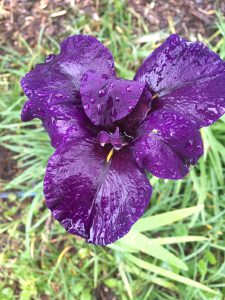
A Louisiana iris hybrid. Credit: Mark Tancig, UF/IFAS Extension Leon County.
Louisiana Iris (Iris spp.)
The name Louisiana iris refers to five true Iris species – I. brevicaulis, I. fulva, I. giganticaerulea, I. hexagona, and I. nelsonii – that are native in and around Louisiana. They easily hybridize with each other and these hybrids have become popular garden cultivars. Louisiana iris prefer moist soils and full sun.
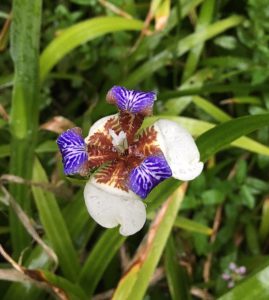
Walking Iris (Neomarica gracilis). Credit: Mark Tancig, UF/IFAS Extension Leon County.
Walking Iris (Neomarica spp.)
Another unofficial iris, most plants in the Neomarica genus share the same “walking” attribute. Small plantlets can develop at the top of the flower stalk and then fall over to start a new clump of plants. These do best in part shade to shade and have a long flowering period. They are somewhat cold tender so may die back but will return in the spring.
Yellow Flag Iris (Iris pseudoacorus)
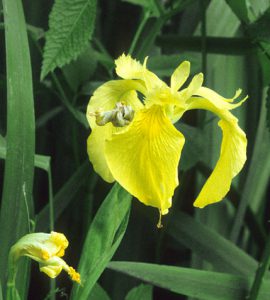
The invasive, exotic yellow iris. Credit: Ann Murray, UF/IFAS.
This non-native Iris is one that you want to keep out of the garden. Yellow flag iris is known to invade natural wetlands and has been designated invasive by the UF/IFAS Assessment of Non-Native Plants. It’s easily distinguished from the other irises listed above by its bright yellow flowers. If you have this iris, remove fruit and carefully dig out the rhizomes, place in a trash bag, and dispose of it in your solid waste bin.
For questions regarding iris identification or care, contact your local UF/IFAS Extension Office.
by Ray Bodrey | May 4, 2018
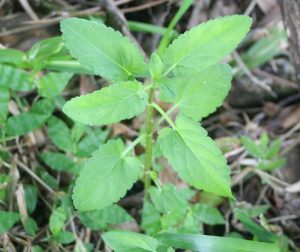
Figure 1: Florida Betony, Stachys floridana. Credit: UF/IFAS Range Cattle Research & Education Center.
If you look closely at your yard, there is a good chance that you will find a plant that, depending on who you ask, is considered either a native wildflower or a weed and there are more than a few species that fit this description. If, upon even closer inspection, you find a plant with root tubers that resemble egg casings or even a rattlesnake’s rattle, you’ve stumbled upon Florida Betony.
Stachys floridana is a perennial broadleaf commonly referred to as rattlesnake weed due to it’s fleshy, white, segmented underground tubers. The plant has an erect stem with leaves that are opposite, shovel-shaped and coarsely serrated. The plant structure is very similar to mint. Flowers, emerging in late spring, are pinkish-purple in color. These inflorescences will also produce fruit, consisting of four nutlets. However, reproduction of the plant and it’s propensity to spread through lawns and gardens primarily occurs through dense root tuber development. Florida Betony’s growing range was originally confined to the state of Florida, but the commercial nursery trade played a major hand in dispersing the plant across the Southeast in the mid-1900’s. It can now be found as far west as Texas and as far north as North Carolina.
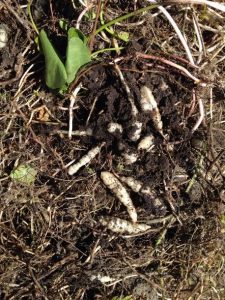
Figure 2: Tubers of the Florida Betony. Credit: Jill Bebee, UF/IFAS Gulf County Master Gardener.It can now be found as far west as Texas and as far north as North Carolina.
This time of year is when Florida Betony thrives. The moderate temperatures of fall and spring are the prime growing periods for Betony. In the heat of the summer, the above-ground structure of the plant will struggle and often disappear completely, only to reemerge in the fall. As a lawn weed, managing tuber development is key to controlling this plant. Applying herbicide to the leaves and stalk may seem at first to have conquered the weed. However, in most cases the tuber will simply regenerate. Glyphosate (Roundup) can be used effectively for control in ornamental plant beds where no turf is present. Be careful when spraying herbicides around trees, shrubs and other desirable plants as any foliar contact will cause phytotoxicity. If you have an infestation of Florida Betony in your turfed areas, there are a few options for control. Regular applications of three way broadleaf herbicides, such as mixtures of 2-4D, Dicamba and Mecoprop, are effective at suppressing this pesky plant. For more information and options, please contact your local county extension office or see the supporting information links below. Always refer to the product label for specific uses, precautions and application rates when using any herbicide.
Supporting information for this article can be found in the following the UF/IFAS EDIS publication, “Florida Betony Biology and Management in Turf” by J. Bryan Unruh, Ramon G. Leon, and Darcy E. P. Telenko: http://edis.ifas.ufl.edu/pdffiles/EP/EP38800.pdf
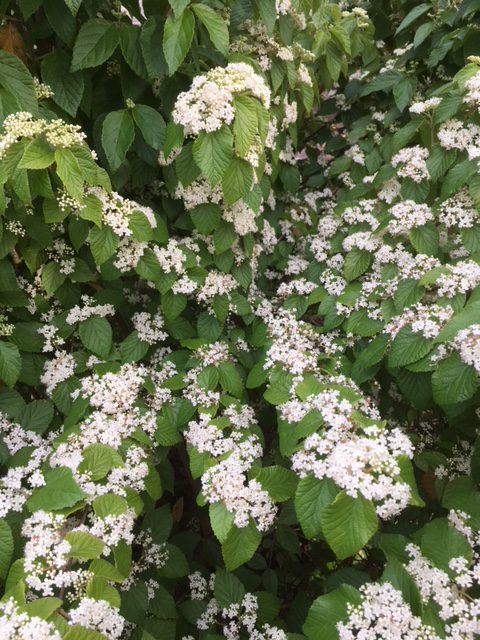
by Julie McConnell | Apr 16, 2018
I’m hard pressed to tell you my favorite song, movie, or place to eat, but when we start talking plants I can come up with whole categories of favorites. I won’t commit to just one species, but when it comes to woody shrubs I am a huge fan of viburnums. We have small ones, tall ones, evergreen, deciduous, smooth leaves, textured leaves, berry producers and sterile types. There are so many different types there must be one for every gardener.
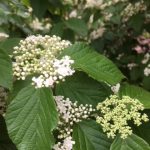
Buds and flowers of Viburnum luzonicum. Photo: J_McConnell, UF/IFAS
I thought I knew a lot of viburnums after spending ten years in the nursery industry, but had not seen Luzon Viburnum, Viburnum luzonicum, until Dr. Gary Knox gave one to me in the fall of 2014. The plant was little more than a couple of stems and light green leaves, but he assured me it would get large and would perform well in the Florida panhandle.
That scrap of a plant went into a large, non-irrigated, full-sun bed in my yard and was hand-watered through the first summer, but after that has been left to fend for itself. My Luzon viburnum is currently over 6 feet tall by 4 feet wide and covered in flowers. It gets no TLC in my landscape, but has yet to be plagued by any pests. The foliage emerges with a slightly pink tone then settles into a light green usually starting in February or March. By late March clusters of small white flowers cover the shrub. It is reported to have the potential to produce berries that transition from red to black, but I have not yet observed that in my garden.
This is not a plant you are likely to stumble across in most garden centers, but is worth keeping a lookout for in case you see it. It is on display with many other wonderful plants in the Gardens of the Big Bend at the UF/IFAS North Florida Research and Education Center (NFREC) in Quincy and in the past has been available at Gardening Friends of the Big Bend plant sales.
For more information about this plant see Missouri Botanical Garden webpage.
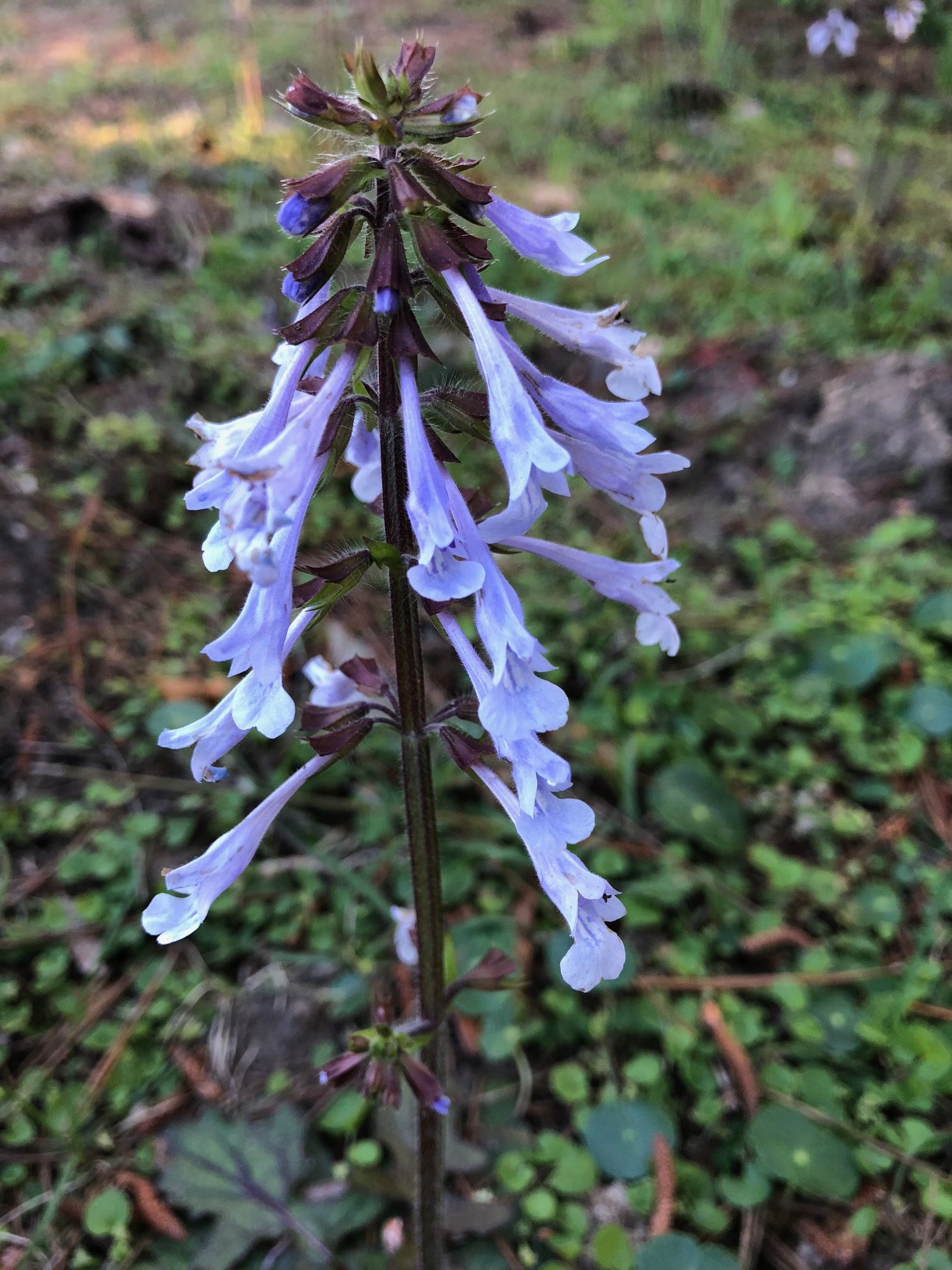
by Mary Salinas | Mar 26, 2018
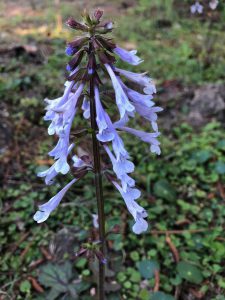
The spike of lavender blooms of lyreleaf sage. Photo credit: Mary Salinas.
Spring wildflowers are popping up along our roadways and along woodland edges. One of our native perennial beauties you can enjoy right now is lyreleaf sage, Salvia lyrata, with spikes of tubular lavender flowers rising about a foot above the ground. The blooms, which occur late winter through late spring, attract bees and butterflies and provide them a good source of nectar. It also is a good host plant for aphids, which in turn, can make it a good banker plant and feeding station for ladybug larvae.
The irregularly-shaped leaves grow in a rosette hugging the ground and can make for a natural ground cover in part shade areas. These attractive leaves are easily identifiable by their purple stems, edges and veins in sharp contrast to the bright green of the rest of the leaf. Lyreleaf sage belongs to the mint family and shares the characteristic square-shaped stems and two-lipped flowers.
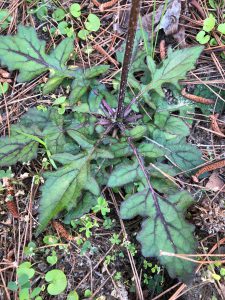
Leaves of lyreleaf sage form a ground hugging rosette. Photo credit: Mary Salinas.
Whatever garden conditions you have, lyreleaf sage should be able to adapt. It tolerates drought, flooding and most soil types. Be aware, though, that this beauty produces lots of seed and can spread quickly. This can be a very desirable trait for establishing a wildflower meadow but challenging if you want to keep it contained in a small area. To manage its’ spread, remove flower spikes after the blooms fade to prevent most seed formation.
Lyreleaf sage can usually be found in native plant or local nurseries; seed can be found through online wildflower seed sources.
For more information:
Planting and Care of Salvias in Landscapes
Florida Wildflower Foundation

by Sheila Dunning | Feb 26, 2018
Weather sayings can be quite colorful. Some of them may be connected to scientific observations, while others are more superstitious in nature. What the weather will do this month can change on a moment’s notice. March is definitely one of the more unpredictable months. One week the temperatures are warm and spring-like. A few days later the weather turns stormy and cold. Depending on the groundhog you follow, spring will be here, or not, in the next few weeks.
But, any long time Northwest Florida residents knows, summer will be here eventually and it is going to get hot and dry. So, while trying to figure out whether to wear your T-shirt or arctic parka today, take a moment to locate that patch of the landscape and consider adding a “lion” or “lamb.”
 Lion’s ear and Lamb’s ear are two plants that survive under hot, dry conditions. Lion’s ear, Leonotis nepetifolia, is a tall-growing (8 feet) annual with orange tubular flowers that peek out of the spiny bloom head, giving the appearance of a lion’s ear. Hummingbirds reportedly hover next to a flower or even perch on a cluster, drinking for 10 seconds or longer. That’s an eternity in hummer world and about as long as any lion would tolerate someone messing with his ears.
Lion’s ear and Lamb’s ear are two plants that survive under hot, dry conditions. Lion’s ear, Leonotis nepetifolia, is a tall-growing (8 feet) annual with orange tubular flowers that peek out of the spiny bloom head, giving the appearance of a lion’s ear. Hummingbirds reportedly hover next to a flower or even perch on a cluster, drinking for 10 seconds or longer. That’s an eternity in hummer world and about as long as any lion would tolerate someone messing with his ears.
Lamb’s ear, Stachys byzantina, is an easy care perennial with wooly gray-green leaves and lavender colored flower spikes. It makes an attractive accent in a container or excellent groundcover that invites you to experience its soft “wool”, like those cute little ears of a baby sheep.
Both of these plants are self-sustaining species that establish well in open dry areas. The lion’s ear must self sow seed to return each year. Whereas, the lamb’s ear will return from the roots and can be divides if you want to relocate them.
Lion or lamb, March is a good time to plan for easy care, summer, blooming flowers. While it may be “freezing” now, you know once it gets hot, the last place you will want to be is outside in the blazing sun. Maybe the thoughts will warm you. For information on good perennials for Northwest Florida go to: http://edis.ifas.ufl.edu/mg035

by Carrie Stevenson | Jan 25, 2018

Ghost plant/Indian pipes emerging from the ground. Photo credit: Carol Lord, UF IFAS Extension
Imagine you are enjoying perfect fall weather on a hike with your family, when suddenly you come upon a ghost. Translucent white, small and creeping out of the ground behind a tree, you stop and look closer to figure out what it is you’ve just seen. In such an environment, the “ghost” you might come across is the perennial wildflower known as the ghost plant (Monotropa uniflora, also known as Indian pipe). Maybe it’s not the same spirit from the creepy story during last night’s campfire, but it’s quite unexpected, nonetheless. The plant is an unusual shade of white because it does not photosynthesize like most plants, and therefore does not create cholorophyll needed for green leaves.
In deeply shaded forests, a thick layer of fallen leaves, dead branches, and even decaying animals forms a thick mulch around tree bases. This humus layer is warm and holds moisture, creating the perfect environment for mushrooms and other fungi to grow. Because there is very little sunlight filtering down to the forest floor, the ghost flower plant adapted to this shady, wet environment by parasitizing the fungi growing in the woods. Ghost plants and their close relatives are known as mycotrophs (myco: fungus, troph: feeding).

Ghost plant in bloom at Naval Live Oaks reservation in Gulf Breeze, Florida. Photo credit: Shelley W. Johnson
These plants were once called saprophytes (sapro: rotten, phyte: plant), with the assumption that they fed directly on decaying matter in the same way as fungi. They even look like mushrooms when emerging from the soil. However, research has shown the relationship is much more complex. While many trees have symbiotic relationships with fungi living among their root systems, the mycotrophs actually capitalize on that relationship, tapping into in the flow of carbon between trees and fungi and taking their nutrients.
Mycotrophs grow throughout the United States except in the southwest and Rockies, although they are a somewhat rare find. The ghost plant is mostly a translucent shade of white, but has some pale pink and black spots. The flower points down when it emerges (looking like its “pipe” nickname) but opens up and releases seed as it matures. They are usually found in a cluster of several blooms.
The next time you explore the forests around you, look down—you just might see a ghost!


















